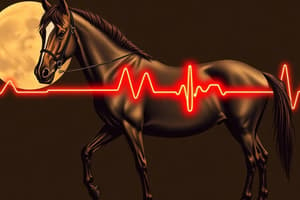Podcast
Questions and Answers
What is the function of the atria in the heart?
What is the function of the atria in the heart?
- Regulating blood pressure
- Pumping blood
- Oxygenating blood
- Receiving blood (correct)
What is the name of the remnant of the foramen ovale in an adult heart?
What is the name of the remnant of the foramen ovale in an adult heart?
- Papillary muscle
- Interatrial septum
- Trabeculae carnae
- Fossa Ovalis (correct)
What is the name of the valve that separates the left atrium and ventricle?
What is the name of the valve that separates the left atrium and ventricle?
- Mitral valve (correct)
- Aortic valve
- Tricuspid valve
- Pulmonary valve
What is the name of the sound produced by the closure of the AV valves?
What is the name of the sound produced by the closure of the AV valves?
What is the name of the valve that separates the right ventricle and pulmonary artery?
What is the name of the valve that separates the right ventricle and pulmonary artery?
What is the term for the rapid filling of ventricles?
What is the term for the rapid filling of ventricles?
What is the term for the contraction of the heart controlled by the parasympathetic nervous system?
What is the term for the contraction of the heart controlled by the parasympathetic nervous system?
What is the function of the trabeculae carnae in the heart?
What is the function of the trabeculae carnae in the heart?
What is the term for the contraction of the atria?
What is the term for the contraction of the atria?
What is the name of the largest vein in the body?
What is the name of the largest vein in the body?
Flashcards are hidden until you start studying
Study Notes
ECG
- P Wave: atrial depolarization
- QRS Complex: ventricular depolarization
- T Wave: ventricular repolarization
- PR Interval: beginning of P wave to beginning of QRS Complex
- QT Interval: beginning of QRS Complex to end of T wave
- PR Segment: end of P wave to beginning of QRS Complex
- ST Segment: end of QRS Complex to beginning of T wave
ECG Conditions
- Prolonged PR Interval: Heart Block
- Wide, Odd, Bizarre QRS Complexes: Premature Ventricular Contraction (PVC)
- ST Segment Elevated: Myocardial Infarction (death of the myocardium)
- ST Segment Depressed: Myocardial Ischemia (lack of blood in the myocardium)
Auscultation of the Valves
- Location of valves: A (aortic), P (pulmonary), M (mitral), T (tricuspid)
- Auscultation points: A (right 2nd ICS, sternal border), P (left 2nd ICS, sternal border), M (left 5th ICS, midclavicular line), T (right 4th ICS, sternal border)
Cardiovascular Conditions
- Heart Disease: Pericardial Friction Rub
- Congenital Anomalies:
- Hereditary Shunts
- Atrial Septal Defect (ASD)
- Ventricular Septal Defect (VSD)
- Coarctation of Aorta
- Patent Ductus Arteriosus (PDA)
- Tetralogy of Fallot (TOS)
- Conditions Affecting the Heart Valves:
- Stenosis: inability of the valve to open fully
- Insufficiency: inability of the valve to close fully
- Prolapse: excessive bulging of the cusp of the valve
Heart Chambers
- Atria:
- Receiving chambers
- Anterior wall of the atria is rough due to the presence of pectinate muscle
- Fossa Ovalis: remnant of foramen ovale
- Ventricles:
- Pumping chambers
- Ridges of cardiac muscle fiber: trabeculae carnae
- Papillary muscle: cone-shaped structure of trabeculae carnae where the chordae tendinae are attached
Heart Valves
- AV Valves:
- Inlet valves
- Tricuspid and bicuspid (mitral) valves
- SL Valves:
- Outlet valves
- Pulmonic and aortic valves
Blood Flow of the Heart
- IVC: largest vein in the body
- Left side of the heart: ↑pressure
- Right side of the heart: ↓pressure
Heart Sounds
- S1: LUBB, closure of AV valves
- S2: DUBB, closure of SL valves
- S3: Rapid filling of ventricles, may be present in CHF
- S4: Atrial systole, may be present in MI/Hypertension
Controlling Centers of the Heart
- Autonomic Nervous System (ANS)
- Para: ↓ contraction, slow contraction of the heart
- Sympa: ↑ contraction, fast contraction of the heart
Studying That Suits You
Use AI to generate personalized quizzes and flashcards to suit your learning preferences.



